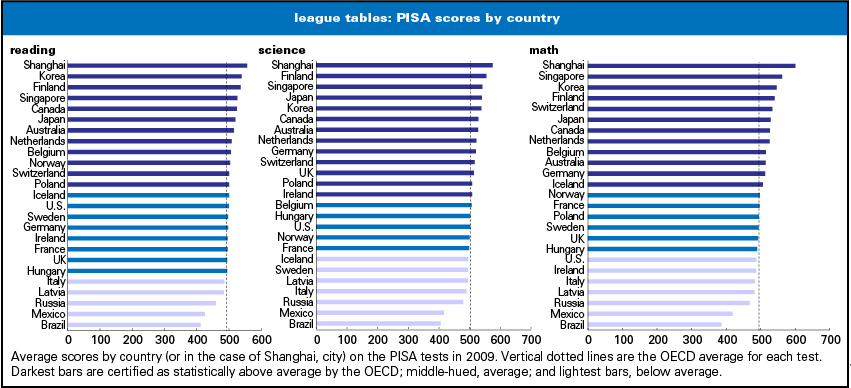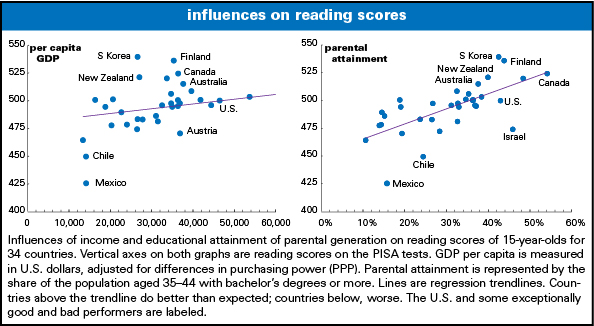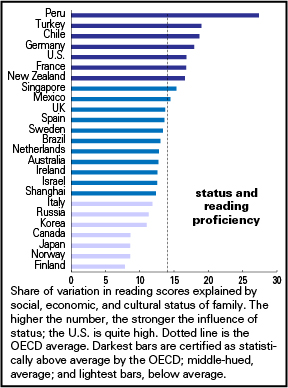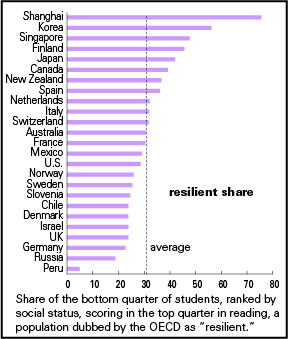
Home Mail Articles Supplements Subscriptions Radio
The following article appeared in Left Business Observer #133, August 2011. Copyright 2011, Left Business Observer. It’s part of a series on education. Other articles include: Do charter schools work? If so, for whom? • explaining test scores • education spending & enrollment: U.S. not so good
Like this? Subscribe today! There’s a lot more where this comes from—and only some of it makes it to the web for free consumption.
The latest take on what’s wrong with our schools
Though pundits and politicians bewail the state of American education, they show a lack of interest in how things are done elsewhere. Here’s an attempt to fill that gap.
Since 2000, the Organisation for Economic Cooperation and Development (OECD), the Paris-based official think tank mainly sponsored by the world’s rich countries, has been administering a battery of of internationally comparable tests every three years. Known as the Programme for International Student Assessment (PISA), it measures achievement in reading, math, and science among 15-year olds in 34 OECD member countries (mostly rich ones) and 31 “partners” (mostly middle-income “developing” countries). In the case of China, only selected cities, notably Shanghai, were tested. Shanghai isn’t representative of the rest of China, but its results are formidable.
Tests are, of course, deeply flawed instruments. But as tests go, PISA looks to be pretty good. What does it tell us?
To start with, it tells us—much like the international health care stats—that the U.S. doesn’t get good results for the gobs of money it spends. Measured as a share of GDP, the U.S. is one of the world’s biggest spenders on education (for more detail, see LBO #132), but comes in only at the middle of the PISA league tables. Finland, which reguarly scores near the top, is at the middle of the spending ranks. (See graphs below.) When the right says that improving education is not a matter of money, they’ve got half a point.

Obviously, the richer a country is, the better educated its population is likely to be. But as the graph on the left just below shows, the relationship is noisy. The trendline “explains” only 2% of the relationship between income and reading scores. Departures from that line are interesting. Chile, Mexico, and Austria do considerably worse than their income levels would warrant. South Korea, Finland, Canada, Australia, and New Zealand all do considerably better. The U.S. is right where it “should” be—but given the similarities among the U.S., Canada, Australia, and New Zealand, all settler offshoots of Britain, the U.S. looks like a slacker.
A better predictor of reading scores is the educational attainment of the tested kids’ parental generation. The statistical fit is far better, with the parental generation’s attainment explaining 43% of the variation in reading scores. Again, the departures from the trendline are interesting. Some of the same countries outperform and underperform, though Canada drops off the list of outliers and Israel (which has really stinted on education lately) joins. The U.S. sags.

Another good predictor is the share of the population of low economic, social, and cultural status, an OECD composite indicator that includes things like the educational attainment of parents, household income, and the number of books in the home. About 10% of U.S. students are of low status, below the OECD average—but that average is pulled up by high shares in poorer countries like Mexico and Turkey. The Western European social democracies, not surprisingly, mostly have lower shares than the U.S. Still, the mapping of reading scores onto social status is imperfect: it explains, statistically speaking, about 45% of the variation in scores. You could perform similar exercises with science and math scores.
As with the other relationships, the departures from prediction are interesting. The U.S.’s mediocre reading scores are pretty much in line with the prediction of a statistical model—but a familiar set of countries outperform (Finland and Korea) and underperform (Israel, Chile, Mexico) the predictions. Shanghai and Kyrgyzstan have virtually identical sociocultural scores—but Shanghai has the best reading scores and Kyrgyzstan the worst. Background matters, but so do schools.
As LBO has noted in previous installments of this education series (e.g. here), poverty explains a lot of the variation in U.S. educational outcomes. But the experience of other countries shows that it doesn’t have to be this way. The way to neutralize the effects of poverty is to devote more resources to poor children. That’s not the way it works here, though; given the intensely local nature of school funding, resource allocation intensifies the effects of our skewed income distribution rather than mitigating it. As a result, among the rich countries, the U.S. has the most unequal distribution of income and one of the strongest relationships between socio-cultural background and outcome. (See graph below.) Some poorer countries, mostly in Latin America, do worse, but it’s hard to imagine anyone bragging that we do better than Peru.

A number of progressive analysts of U.S. education, with the estimable former conservative Diane Ravitch prominent among them, emphasize the importance of poverty to our poor educational outcomes. There’s a lot of truth to this, but what that overlooks is that we also do very badly at compensating for poverty (and it overlooks the mediocrity of the middle). In better-performing countries, schools with poorer students get more resources, not fewer. But that’s not the drift of current policy (or mainstream “reform”). Consequently, we’re very bad at nurturing what the OECD calls “resilience” (see graph below).

As with many things, the U.S. distribution of reading skills is severely polarized. The share of students scoring in the very highest level of proficiency, 1.5%, is well above the OECD average, and only a hair below Finland’s. But the share scoring in the mediocre and worse categories is quite large—twice Finland’s and nearly three times Korea’s. But the share in the good but not great categories is low compared to the standouts.
That’s on reading. On math, we’re worse, with a small share in the best category (below the OECD average, and well below the top performers), a middling amount in the middle, a bloated share at the bottom—and a very wide gender gap (with boys outperforming girls). Boys outperform girls in math in most countries, though not all—but girls in 19 countries outperform American boys, including nonrich places like Estonia and Slovenia. Similar things can be said about science: mediocre performance with a large gender gap.
Moving down from the very top, it’s really hard to find any area where the U.S. does well. Our share of students scoring in the top two (out of six) categories in comes in at #11, and slightly above average; in math, at #30, well below average; and in science, at #18, and just a hair above average. In other words, our very best students are very good, but as soon as you step down from the elite level, performance deteriorates badly.
Why should we care about education? You could argue that school is just a way for The Man to turn us into obedient, productive automatons. And that it can be. But there’s a lot of research showing that education can make people healthier and less likely to take up a criminal career. And it’s not like the mediocre education enjoyed by most Americans is making us particularly creative or rebellious.
Work on the relationship between PISA scores and economic growth suggest that if the U.S. could get up to Finnish levels, our GDP growth per capita would be about 0.8 point a year higher; if we could get to Shanghai’s levels, it would be 1.4 points higher. The underlying reasoning is that better-educated workers are more productive and more likely to come up with technological innovations. No doubt this statistical relation is imprecise and probably overstated, but the general point probably has some merit. Even an increase of 0.4 point in our long-term growth prospects would be significant. Over the last 30 years, U.S. GDP per capita growth has averaged 1.7%. Extrapolating that 1.7% rate over the next 30 years, 2010’s GDP per capita of about $47,000 would rise to $78,000 (in today’s dollars). Boosting that growth rate to 2.1% would add $10,000 to 2040’s income level. It would also mean that all the hysteria about Social Security and Medicare busting the budget would have to be sent packing.
Of course, talking about growth inevitably brings up questions of distribution and sustainability. Boosting growth rates would be of little help if the top 1% gets all of the increment, or if it contributes to Iowa becoming beachfront property. But if we want to prevent Iowa from becoming beachfront property, it would be helpful to have a population educated enough to understand the risks and to do something about them.
Aside from economic payoffs, a healthier democracy and a less philistine culture would be deeply welcome improvements. A country that can take Rick Perry seriously is one suffering from multiple crises; we’ll leave Katy Perry aside for now.
In a separate volume in the PISA series called Lessons for the U.S., the OECD begins with a number of broad points. It looks at several national systems as models—Japan and Finland for consistently outstanding performance; Ontario not only for its high performance but proximity and similarity to the U.S.; Germany, for having gotten scared by its low rankings in early PISA exercises and resolving (successfully) to do a lot better; and Brazil, for great improvement against great socioeconomic odds. In the most successful systems, teachers are treated as high-level professionals; curricula emphasize creativity and complex skills; work organization is flat and collegial rather than hierarchical and authoritarian; accountability is to peers and stakeholders, not the authorities; and all students, not merely the best ones, are expected to learn at high levels. The U.S. scores poorly on many of these criteria, and many of our “reforms” take us in a worse direction.
Like the U.S., Canada has a decentralized school system with a heterogenous population and lots of immigrants. As with Germany, low rankings on the early PISA tests prompted the government to push for serious school reform.
The OECD points to some pre-existing strengths in Canadian society that made positive reforms easier. Canadian kids are more likely to read for pleasure than any other country in the world, and a decent welfare state that offers good health care even for the poor and an income support system that, while well short of Scandinavian levels of generosity, does mitigate “the vicissitudes of capitalism” (the OECD’s phrase). Further, the OECD remarks: “[T]he idea of a welfare state and a common good is much more firmly entrenched in Canada than in its more individualistic neighbour to the south (the US). The idea that health care and other social services are a right and not a privilege carries over into education, where there is a broadly-shared norm that society is collectively responsible for the educational welfare of all of its children. The combination of this norm with the protection afforded by the welfare state creates a climate in which school success is expected for all students.” Remember, this is the OECD, a thoroughly bourgeois institution, speaking.
But those were long-standing features of the Canadian system; what’s interesting are the kinds of reforms that took place in Ontario, under a Liberal government that took office in 2003. The liberals, led by premier Dalton McGinty, succeeded a deeply reactionary regime, led by Mike Harris, whose education policies featured cost-cutting, school choice, “demonising teachers” (the OECD’s phrase), promotion of private schools, and extensive testing. (Sound familiar?)
McGinty led a dramatic shift away from Harris-style policies. At the center of the reforms was teacher development—improving their skills, and working with them. The provincial government, says the OECD, “drew a sharp contrast between its capacity-building approach…and the more punitive versions of accountability used in the United States.” Their approach was collegial and cooperative, not competitive. No one spoke of tying pay to performance.
Going into these reforms, Canada had another advantage besides its health care system—teachers had long been recruited from among the top third of secondary school grads. According to a McKinsey study, a characteristic of all high-scoring systems is degree to which prospective teachers are drawn “from the top end of the talent pool.” (In Finland, it’s more like the top fifth.) But, as one Canadian teacher told the OECD researchers: “Everyone knew that there was a loophole—you could always cross the border to the United States. Anyone can get credentialed there.”
This is something that almost no one in the U.S. wants to talk about. Progressives are understandably reluctant to criticize teachers, given the many good ones we have and the slanderous attacks they’ve been under, but teaching is just not a well-paid or prestigious profession in the U.S. Because of that—and because of the profound anti-intellectualism of the culture (something else a lot of progressive education pundits don’t like to talk about either)—education schools don’t consistently draw the most vigorous candidates. According to the College Board, average SAT scores for seniors planning to go into education fall into the bottom third.
In successful systems like Ontario and Finland, teachers have a great deal of professional autonomy. There may be a national curriculum, but teachers are expected to know their subject well and develop their skills at imparting knowledge. Finland requires master’s degrees even for primary teachers; in most successful systems, master’s are typical or even required in the subject area for secondary teachers. In some Asian systems, new teachers serve as apprentices to master teachers before they’re allowed to run their own shows. There are no generalists just thrown to the wolves, as in the U.S.
And in most successful systems, standardized tests are rare, and are generally administered only at major breakpoints, like entrance into or graduation from high school. Administrators of top systems are very conscious of what other high-achieving countries do, and try to emulate what they can. The contrast with the U.S. is stark. In fact, there’s no other country that does anything like what we are doing—the testing, the punitive evaluations, the vendetta against “bad” teachers. And most U.S. education specialists are largely unaware of what’s going on abroad.
Back in the 1990s, Finland consciously chose to improve its educational system to move away from a resource-based economy towards a high-tech one. It’s succeeded. China has made a similar decision, to support a move away from low-tech to higher-tech production. Despite lip-service paid to those sorts of goals in the U.S., most education reform here has focused on cost-cutting and tighter discipline. If you strip away the rhetoric, it looks like the U.S. elite’s long-term plan is for a low-wage, poverty-ridden economy where the bottom 50–75% is supposed to shut up and stay in line. The upper crust will continue to send its kids to crunchy, progressive schools like St Ann’s and Sidwell Friends. But for everyone else, it’s going to be rules, poorly paid teachers, and lots of tests. And from there, it’s on to McDonald’s if you’re lucky, or jail, if you’re not. Of course, no one says that—but by their deeds ye shall know them.
Home Mail Articles Stats/current Supplements Subscriptions Radio